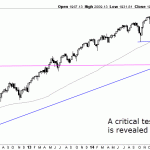“You get recessions, you have stock market declines. If you don’t understand that’s going to happen, then you’re not ready, you won’t do well in the markets.” – Peter Lynch
With the financial markets in “turmoil” in early 2016, the most common question asked of economic forecasters: “is the U.S. economy heading into another recession?”
At the February lows (1810 on the S&P 500, 15% correction), many answered yes. The stock market is a leading indicator of the economy, they argued, ignoring the many Bear Markets in history that weren’t associated with recessions (most recently in 2011).

With the S&P 500 over 10% higher today, more forecasters seem to be hedging that opinion. That’s to be expected, of course, as many pundits simply form their narrative on the economy based on the recent direction of the S&P 500. Higher = good economy; lower = bad economy.
But I digress.
What I find most interesting in the responses to the recession question is when they assign a specific probability of a contraction occurring. At the February lows, one notable soothsayer said there was a 50% chance of a recession this year. Another said the odds were higher, at 65%. Still another fortune-teller said there was a 100% probability.
Thinking in terms of probabilities in markets is a generally a good thing (as there is no such thing as certainty), but lost in these prognostications are the following issues:
1) How are you defining recession and are you actually calculating those odds in accordance with that definition or just pulling a number out of thin air?
2) What are the odds of a recession at any given time? How far back in time are you going to determine those odds?
3) What were the times in the past that had similarly high odds with no ensuing recession?
4) By the time you can say with any certainty that the economy is in a recession, is it of any use to investors or does it do more harm than good? Are you equally adept at predicting when a recession is about to end and when investors should get back in?














Leave A Comment